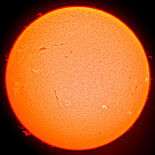Spicule (solar physics)

In solar physics, a spicule is a dynamic jet of about 500 km diameter in the chromosphere of the Sun. It moves upwards at about 20 km/s from the photosphere. They were discovered in 1877 by Father Angelo Secchi of the Vatican Observatory in Rome.
Description
Spicules last for about 15 minutes;[1] at the solar limb they appear elongated (if seen on the disk, they are known as "mottles" or "fibrils"). They are usually associated with regions of high magnetic flux; their mass flux is about 100 times that of the solar wind. They rise at a rate of 20 km/s (or 72,000 km/h) and can reach several thousand kilometers in height before collapsing and fading away.
Prevalence
There are about 300,000 active spicules at any one time on the Sun's chromosphere, amounting to about 1% of the Sun's surface.[1] An individual spicule typically reaches 3,000-10,000 km altitude above the photosphere.[2]
Causes
Bart De Pontieu (Lockheed Martin Solar and Astrophysics Laboratory, Palo Alto, California, United States), Robert Erdélyi and Stewart James (both from the University of Sheffield, United Kingdom) hypothesised in 2004 that spicules formed as a result of P-mode oscillations in the Sun's surface, sound waves with a period of about five minutes that causes the Sun's surface to rise and fall at several hundred meters per second (see helioseismology). Magnetic flux tubes that tilted away from the vertical can focus and guide the rising material up into the solar atmosphere to form a spicule. There is still however some controversy about the issue in the solar physics community.
References
- 1 2 Freedman, Roger A.; Kaufmann III, William J. (2008). Universe. New York, USA: W. H. Freeman and Company. p. 762. ISBN 978-0-7167-8584-2.
- ↑ §1, Two Dynamical Models for Solar Spicules, Paul Lorrain and Serge Koutchmy, Solar Physics 165, #1 (April 1996), pp. 115–137, doi:10.1007/BF00149093, Bibcode: 1996SoPh..165..115L.
Literature
- De Pontieu, B., Erdélyi, R. and James, S: Solar chromospheric spicules from the leakage of photospheric oscillations and flows In: Nature. 430/2004, p. 536–539, ISSN 0028-0836
